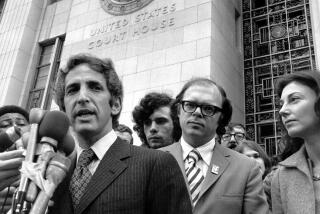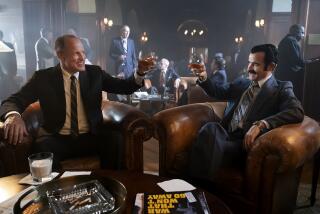Why Did It Take ‘Final Days’ So Long to Become a Movie?
- Share via
What took so long to do “Final Days,” the television movie? After all, “All the President’s Men”--the first Bob Woodward/Carl Bernstein book about their Watergate reporting, coverage that won the Washington Post a Pulitzer--became a feature movie in 1976, in just two years.
According to Woodward: “A couple of people wanted to option (“Final Days”) or buy it as a (feature) movie, but we said no . It was a little too immediate, nerves were raw, and then it was gone.”
Yet when the authors might have said yes, no one asked. “You know how the culture has a three-minute attention span,” he said.
Nerves were indeed raw. A rash of controversy broke out over the book, which had 394 unnamed sources; the authors, who said no one would talk to them without protection of anonymity, vigorously defended their work.
Nixon son-in-law David Eisenhower said he never told them he feared Nixon might commit suicide. Son-in-law Edward Cox claimed that he never said Nixon was pacing the halls at night “talking to the pictures on the wall.”
Secretary of State Henry Kissinger, who met with Nixon in a private prayer session the night before Nixon announced his resignation, disputed the account and later wrote that he did not remember Nixon “beating his fist on the carpet and railing against a cruel fate.” Chief of Staff Alexander Haig denied talking to the authors. Nixon lawyer J. Fred Buzhardt called the book “psychojournalism.” And Nixon blamed “Final Days” for a stroke that Pat suffered.
A harsh reminder of those controversies emerged from the Nixon camp when its members learned of the TV movie based on “The Final Days.” As principal photography began in late January, Nixon aide John Taylor circulated a memo among the ex-President’s family, friends and “RN loyalists,” urging them to “refuse to have anything to do with (the movie) or indeed for the time being with ABC” because of “the singularly odious and vicious nature” of a movie based on “The Final Days.”
Asserting that the producers were concealing the “true nature” of the movie, Taylor accused them of “covering up.”
Taylor based his coverup claim on the fact that producers early on used “E.O.B” (for Executive Office Building) as a working title. He said “E.O.B.” was used to hide the connection to Woodward and Bernstein’s book. Samuels, however, said the title was used for “low visibility” because “Final Days” was “a non-union picture and we simply didn’t want to draw a lot of attention to ourselves.” Meanwhile Taylor allowed he would be upset by any movie about the Nixon presidency that focused just on those final days.
A lot of the incidents that drew complaints about the Woodward/Bernstein book are in the movie--suggestions that Nixon thought about suicide, talked to pictures, pounded his fist on the carpet. And so is Nixon’s moving plea to Kissinger after the prayer scene: “Henry, please don’t ever tell anyone that I cried and that I was not strong.”
Still Hugh Whitemore chose not to include embarrassing material about the Nixons’ personal relationship. In the book, Woodward and Bernstein said the Nixons had “not really been close since the early 1960s,” that Pat wanted a divorce after her husband lost the California governorship in 1962 and she “tried and failed to win his promise not to seek office again. Her rejection of his advances since then had seemed to shut something off inside Nixon.”
In the docudrama, there is only one shot of the couple, as political pressures mounted, in the Lincoln Sitting Room. They do not speak. Further treatment of their relationship, Whitemore said recently from London, would be “irrelevant. I don’t believe this sort of film should start going beyond bedroom doors.”
Although the book’s lack of footnotes fanned the controversy, the script has 20 footnote codes, including “FD” for “material dramatized directly from the book.”
More to Read
Sign up for our Book Club newsletter
Get the latest news, events and more from the Los Angeles Times Book Club, and help us get L.A. reading and talking.
You may occasionally receive promotional content from the Los Angeles Times.








